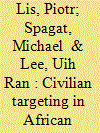|
|
|
Sort Order |
|
|
|
Items / Page
|
|
|
|
|
|
|
| Srl | Item |
| 1 |
ID:
182661


|
|
|
|
|
| Summary/Abstract |
Armed conflict actors frequently target civilian populations. Thus, an improved understanding of such behaviour could pave the way to reducing it. We use the Civilian Targeting Index (CTI) and a broad array of geo-referenced data to investigate the spatio-temporal and economic dynamics of civilian targeting by conflict actors in Africa. Two main insights are generated. First, the civilian targeting behaviour of African non-state conflict actors is strongly influenced by the behaviour of other proximate actors. In particular, non-state actors tend to increase their civilian targeting after nearby non-state actors have done so. Possible mechanisms to explain such spatial spillovers include emulation and retaliation. Second, a negative relationship between economic activity and civilian targeting exists and applies to both state and non-state actors. In addition, CTIs of non-state actors tend to increase with population density, the geographical spread of their conflict activity and conflict duration. State actors have higher average CTIs than non-state actors do, but the gap between the two actor types tends to close during long-duration conflicts.
|
|
|
|
|
|
|
|
|
|
|
|
|
|
|
|
| 2 |
ID:
152888


|
|
|
|
|
| Summary/Abstract |
I develop a theory of spatial diffusion of the rule of law, where “space” is conceptualized as shared memberships in economic international organizations (IOs). I argue that the rule of law diffuses as a result of economic competition and socialization. Outside evaluators, such as international leaders, activists, and most importantly, international firms and investors, often assess states’ attractiveness as a business venue by comparing them to similar states. The natural reference group for such comparisons is not just geographical neighbors, but also states with shared memberships in economic IOs. Responding to this evaluation, states identify members of their own reference groups and view them as competition for investment. As a result, states within the same reference groups converge on issues related to lowering domestic economic risks, which are referred to by the umbrella term “domestic rule of law.” The resulting process of policy convergence is further aided by socialization. Socialization may involve emulation of policies of similar states or “active” learning through norm entrepreneurs, who use the reference groups for both evaluation and access to their target audiences. I capture the theorized spatial processes using a multiparametric spatiotemporal autoregressive model (m-STAR) and find support for the prediction.
|
|
|
|
|
|
|
|
|
|
|
|
|
|
|
|
| 3 |
ID:
158990


|
|
|
|
|
| Summary/Abstract |
Are economic sanctions an effective tool for the improvement of global human rights practices? Imposed economic sanctions seem to lead to increased target state repression. However, governments still impose sanctions for the expressed reason of the target's poor human rights practices. If sanctions are detrimental to the enjoyment of human rights, why do governments continue to use them in response to state repression? I argue that sanction activity may improve human rights practices in (1) states threatened with human rights–based economic sanctions and (2) nontarget states whose perceived cost of repression is increased by the example set by target states in their human rights and foreign policy peer groups. Using data on 159 countries from 1981–2005, I demonstrate that, while imposed sanctions are related to worsened human rights practices in target states, threatened human rights sanctions are related to increases in government respect for human rights in both target states and others whose human rights practices and foreign policies are similar to those of target states.
|
|
|
|
|
|
|
|
|
|
|
|
|
|
|
|
| 4 |
ID:
160790


|
|
|
|
|
| Summary/Abstract |
Violence is a key means used by organized crime to assert its control over territory and business. A widespread view is that violence is bound to take place also in the new territories where mafia groups migrate. In this article, we maintain that this view overlooks two important factors. First, criminal organizations acting in nontraditional areas face a structure of constraints and opportunities that do not generally favor the adoption of violence as a successful organizational strategy. Second, we show that violence, when it takes place, results from the transfer of conflicts that have their roots in the territories of origin of criminal groups. Local conditions play a mediating role in shaping violence in the new territories. We provide empirical support for these statements through the quantitative analysis of the violence perpetrated by mafia groups in Italy in the period between 1983 and 2013.
|
|
|
|
|
|
|
|
|
|
|
|
|
|
|
|
|
|
|
|
|